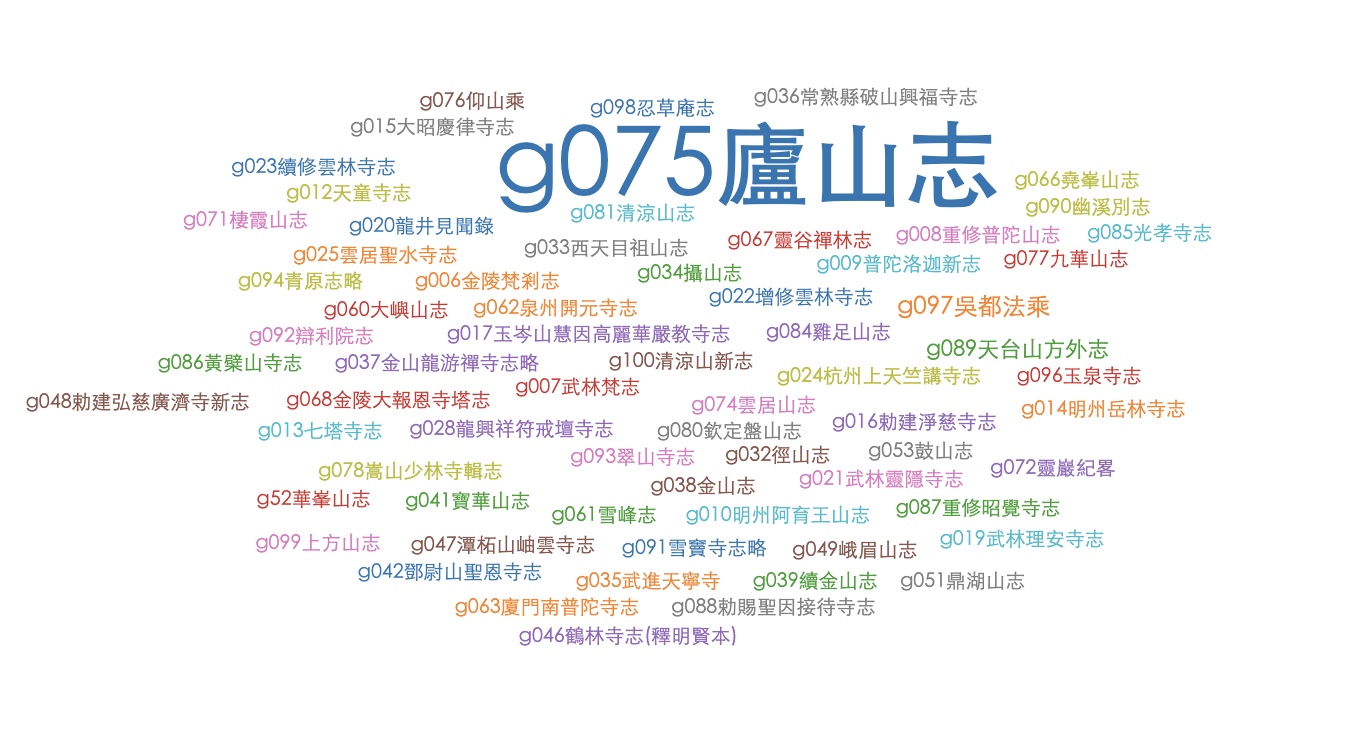
|

|

|
|
本佛寺志人物傳記文本脈絡分析系統,是以明清時期在中國各地所發行的以佛寺為主軸的史志紀錄(簡稱:佛寺志)中所收錄的人物傳記資料為主要內容,所製作之具高度探索功能的主題脈絡分析系統。佛寺志的內容相當多元,涵蓋佛寺的歷史沿革、地理山水、祖師行誼、寺院田產、建築古蹟、重要文獻與藝文創作等等。其中佛寺志內所收錄的人物傳記資料,更是具有相當重要的參考價值。根據我們的初步統計,佛寺志內人物傳記資料內容,約佔整體佛寺志的17%,是僅次於藝文資料的第二大類別。本系統主要利用法鼓文理學院所建置之「中國佛教寺廟志數位典藏」所收錄之《中國佛寺史志彙刊》與《中国佛寺志叢刊》等兩套佛寺志叢書,在抽取其中的人物傳記紀錄後,結合台灣大學數位人文研究中心的DocuSky數位人文平台之功能所製作。讓人物傳記資料不僅可由個別人物主體切入,也保留了人物與入傳寺志間的意義關聯。從時間、空間、寺志的類目結構,透過系統後分類、探勘與分析、參照與視覺化等多重脈絡的互操作性,展開佛學人物議題的深入探索與研究。
The "Biographical Text Context Analysis System for Buddhist Temple Gazetteers" is a context analysis system with many advanced exploratory functions. It is primarily created based on the biographical data contained in historical records of Buddhist temples, commonly referred to as "Buddhist Temple Gazetteers." The content of the Buddhist Temple Gazetteers is highly diverse, covering the history and development of Buddhist temples, geographical landscapes, ancestral lineages, temple land assets, architectural monuments, significant documents, and artistic creations, among other topics. Notably, the biographical texts contained within these gazetteers hold significant research and reference value. According to our preliminary statistics, biographical data makes up approximately 17% of the overall content in the Buddhist Temple Gazetteers, making it the second-largest category after artistic materials. The system is primarily built using the "Digital Archives of Chinese Buddhist Temple Gazetteers" established by the Dharma Drum Institute of Liberal Arts. This archive includes the digitalized version of two important collections of Temple Gazetteers, the “Zhongguo Fosi Shizhi Huika (中國佛寺史志彙刊)” and the "Zhongguo fosizhi congkan (中国佛寺志丛刊)”. After extracting the biographical texts from these collections, the system is developed with the DocuSky digital humanities platform from the Digital Humanities Research Center at National Taiwan University. This allows for biographical data to be accessed not only from the perspective of individual subjects but also preserves the semantic connections between the individuals and the temples. Through the system's classification, mining and analysis, referencing, and visualization functions, users are able to deeply explore and research Buddhist biographical topics across multiple contexts, including time, space, and the structural categories of the gazetteers. This interactivity allows for in-depth exploration and research on topics related to Buddhist figures. 資料授權 Provider:
財團法人中華佛學研究所Chung-Hwa Institute of Buddhist Studies http://www.chibs.edu.tw 資料來源 Resources:
中國佛教寺廟志數位典藏Digital Archive of Chinese Buddhist Temple Gazetteers http://buddhistinformatics.dila.edu.tw/fosizhi/ 建置機構 Institution:
法鼓文理學院Dharma Drum Institute of Liberal Arts 中華佛學研究所 Chung-Hwa Institute of Buddhist Studies 臺灣大學數位人文中心 The Research Center for Digital Humanities, National Taiwan University 相關資源 Related Resources:
中國佛教寺廟志數位典藏Digital Archive of Chinese Buddhist Temple Gazetteers http://buddhistinformatics.dila.edu.tw/fosizhi/ 佛學規範資料庫 Buddhist Studies Authority Database Project https://authority.dila.edu.tw/ |
||||||||||||||||||||
|
分析範例 Analysis Example
|
||||||||||||||||||||

|

|

|
目前總使用人次:未知 人次
©2023 DILA, CHIBS, RCDH of NTU
Digital Object Identifier, DOI
doi:10.6681/NTURCDH.DB_DocuSkyDILA_BTCAS/Text |




